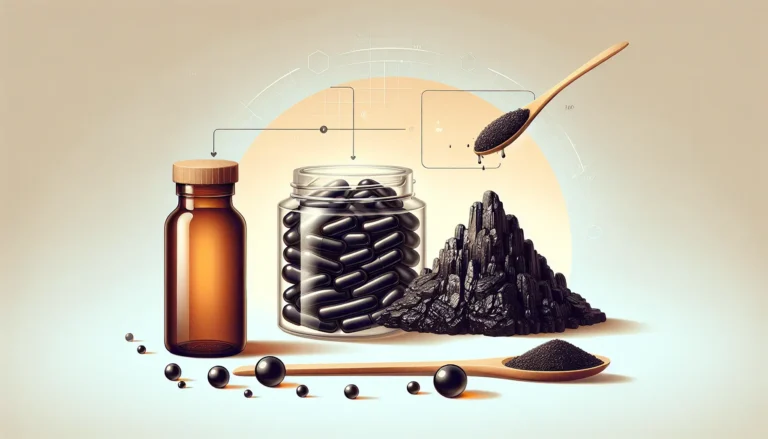Curious about Shilajit? Once famed in Ayurvedic tradition and now the subject of modern science, this potent supplement has a range of potential health benefits and practical applications.
This articl presents you with a clear picture of the effectiveness, safety, and uses of shilajit based on research and historical insights.
Key Takeaways
- Shilajit is a complex natural substance found in high-altitude regions with a composition rich in fulvic acid, humic substances, and various organic compounds, which are believed to confer a range of health benefits.
- Traditionally used in Ayurvedic medicine for over 4000 years, modern research supports shilajit’s potential benefits including antioxidant properties, improved cognitive function, enhanced physical performance, and positive effects on heart and immune health, though more extensive clinical trials are necessary to fully establish these effects.
- While shilajit has been noted for potential health advantages, safety concerns regarding the purity of shilajit and its side effects should be addressed, with a strong recommendation for consulting healthcare providers before supplementation.
Shilajit: Origins and Composition

Shilajit, a sticky substance found primarily in the high mountain rocks of the Himalayas, is the result of a centuries-long process of plant decomposition.
Over time, certain plants, particularly those bearing latex and resin, decompose slowly to form this unique blackish-brown substance. Nestled within calcareous, metamorphic, and sedimentary rocks from various geological eras, shilajit holds a unique place in the annals of natural substances.
Although the Himalayas are the most well-known source, shilajit is not confined to this region. From Russia to the Andean highlands, shilajit graces the rocks of high-altitude regions around the globe.
At the heart of shilajit’s therapeutic properties lie its key components, including fulvic acid and humic substances.
Geographical Distribution
Shilajit’s geographical distribution is as impressive as its health benefits. Found in mountain regions across several countries, including the Pamir Mountains, Afghanistan, Pakistan, Nepal, Bhutan, Russia, and even southern Peru.
Notable mountain ranges where shilajit can be sourced include the Himalayas, spanning multiple countries, the Tibetan and Altai mountains, and the mountains of north Chile.
However, despite its widespread geographical presence, shilajit deposits are very rare and have limited raw material reserves. This rarity makes shilajit even more valuable, contributing to its status as a precious natural substance.
Key Components
The secret to shilajit’s therapeutic properties lies in its complex biochemical composition. Fulvic acid is a principal component of shilajit, contributing significantly to its therapeutic properties. A higher fulvic acid content is often associated with greater potential health benefits.
In addition to fulvic acid, shilajit contains:
- Humic substances, primarily humic and fulvic acids, which are essential to its complex biochemical composition
- A spectrum of trace minerals
- Amino acids
- Other organic compounds like benzoic acid, aromatic carboxylic acids, and fatty acids
These components, known as chemical constituents, make shilajit a potent source of beneficial compounds.
Traditional Uses in Ayurvedic Medicine
For over 4000 years, traditional medicine across various countries, including Afghanistan, India, Iran, Pakistan, China, Nepal, Central Asia, and Tibet, has recognized the benefits of Shilajit.
In these regions, shilajit is hailed as a panacea, a universal remedy for numerous ailments and health conditions. The East has a rich tradition of incorporating shilajit into folk medicine practices, using it in forms such as dry extract or dietary supplements.
In Ayurvedic medicine, shilajit is known for its nourishing effects on blood and bones, contributing to healthy circulation and bone strength. As a “rasayana,” or rejuvenator, shilajit revitalises the body, especially reproductive tissues, and protects against excess vata and premature aging.
Not just limited to rejuvenation, traditionally, shilajit has also been used to manage diabetes and reduce hyperglycemic responses due to its potential anti-diabetic properties.
Shilajit boasts a wide range of benefits, from supporting hair health to enhancing cognitive functions. Let’s delve deeper into two specific areas – rejuvenation and longevity, and cognitive benefits.
Rejuvenation and Longevity
Traditional medicine holds the belief that shilajit has the potential to slow down the aging process, thereby enhancing well-being and contributing to longevity. Shilajit’s anti-aging properties, which contribute to its reputation as a substance that supports healthy aging and longevity, are deeply rooted in traditional wisdom.
However, this is not merely folklore. Fulvic acid, a component of shilajit, has been observed to offer benefits that could support healthy aging.
These benefits include reducing symptoms of dementia and improving sleep and appetite in older adults. This underlines the potential of shilajit in promoting overall health and well-being.
Cognitive Benefits
Shilajit is traditionally believed to not only have rejuvenating capabilities but also improve cognitive activity and provide preventive action in cognitive disorders.
The key to this benefit lies in fulvic acid, a key component of shilajit. Fulvic acid may enhance memory and inhibit the self-aggregation of tau protein, which is a factor in the development of Alzheimer’s.
This cognitive enhancement is supported by fulvic acid’s antioxidant and anti-inflammatory properties. Animal studies have also suggested that shilajit may have benefits for mental health by reducing stress and anxiety.
This outlines the potential of shilajit in promoting brain health and cognitive function.
Potential Health Benefits Backed by Research
Although traditional wisdom has long supported the benefits of shilajit, scientific evidence supporting these claims has only recently begun to surface through modern research. Shilajit has been found to have the following benefits:
- Acts as an antioxidant, combating free radicals and oxidative stress associated with the ageing process
- Has anti-inflammatory properties that may be effective for chronic conditions such as asthma, allergies, and eczema
- Supports healing in cases of gastric ulcers
But the benefits extend beyond that. Shilajit has also been used to improve:
- Immunity
- Cognitive health, reflecting its neuroprotective capabilities
- Reproductive system, with studies indicating benefits such as increased sperm count and motility
- Heart health, potentially aiding in energy production, blood formation, and managing hypoxia, which is essential for high-altitude health challenges
- Gut health, as the fulvic acid present in shilajit enhances gut health, encouraging the growth of beneficial bacteria and improving nutrient absorption.
These potential health benefits of shilajit are fascinating, but let’s take a closer look at three specific areas – Alzheimer’s disease, athletic performance and muscle mass, and heart health and cholesterol.
Alzheimer’s Disease
One of the most promising areas of shilajit research is its potential impact on Alzheimer’s disease. Fulvic acid found in shilajit may inhibit the accumulation of tau proteins, which could otherwise result in cell damage associated with Alzheimer’s disease.
Recent studies have identified specific fractions of Andean Shilajit that impede tau self-aggregation and promote neuritogenesis, with active molecules under investigation for their neuroprotective properties.
Formulations like BrainUp-10, based on Andean Shilajit and supplemented with B vitamins, have shown initial success against Alzheimer’s, evidencing a growing global scientific interest in Shilajit’s research.
However, there’s a consensus on the need for more extensive human trials to fully establish shilajit’s efficacy in Alzheimer’s prevention and treatment.
Athletic Performance and Muscle Mass
Shilajit’s potential benefits aren’t limited to the realms of disease prevention and treatment. It also has potential applications in enhancing physical performance.
Shilajit contributes to improved endurance and exercise performance by enhancing the body’s metabolic characteristics and increasing oxygen delivery to tissues.
Supplementing with shilajit has been linked to:
- Increased muscle mass and strength, attributed to its high mineral content
- Boosted stamina and endurance, further enhancing an individual’s physical performance
- Increased synthesis of type 1 collagen, which is important for maintaining muscle strength and recovery
Daily supplementation with a shilajit supplement can provide these benefits.
Heart Health and Cholesterol
Turning our attention to heart health, Ayurvedic practices have long used shilajit to improve heart health. However, despite these traditional uses, there is currently a lack of large-scale human studies to conclusively support the heart health benefits of shilajit.
More research is necessary to determine the efficacy of shilajit in heart health and cholesterol management. The potential of shilajit in this area is yet another testament to its wide-ranging health benefits and the importance of continued research.
Safety Concerns and Precautions
Like any supplement, safety concerns and precautions should be considered before starting to use shilajit.
Certain individuals may experience increased iron levels and altered hormone levels with shilajit use. Shilajit use may not be safe for small children and older adults due to the lack of safety information available.
Males need to understand the potential side effects of shilajit when taken in higher doses or over extended periods, especially if underlying health issues exist. Individuals with certain conditions like sickle cell anemia, hemochromatosis, thalassemia, or allergies should be cautious with shilajit. If adverse reactions like rash, increased heart rate, or dizziness occur, discontinue use.
It is always recommended to speak with a doctor before using shilajit as more research is needed on its dosage and how it works within the body.
Purification Process
The presence of harmful substances in unprocessed shilajit, such as:
- Mycotoxins
- Heavy metals
- Polymeric quinones
- Free radicals
is one of the major safety concerns associated with shilajit. Raw or unprocessed shilajit can pose health risks due to these potential contaminants.
To avoid these risks, it is imperative to ensure that purified shilajit is ready for use before consumption. The purification process is vital to the safety and effectiveness of shilajit supplementation.
Here at BROWN’S HEALTH, we test all of our supplements for contaminants to ensure safety.
Possible Side Effects
Like any natural substance, shilajit may trigger allergic reactions in certain individuals. Symptoms of an allergic reaction to shilajit could include a rash, an increased heart rate, or dizziness.
Before using shilajit as a substitute for or in combination with ongoing medications, it is advised to consult a qualified physician. The risk of interaction with other drugs can be mitigated by following the advice of an Ayurvedic doctor when considering shilajit supplementation.
How to Choose and Use Shilajit Supplements
There are several considerations when it comes to choosing and using shilajit supplements. To ensure quality, choose shilajit supplements that have been verified for purity and are third-party lab tested.
Before purchasing shilajit, it is advised to consult with a healthcare provider, particularly for those with health concerns or those taking other medications. Healthcare professionals can provide guidance on integrating shilajit into your fitness or health routine.
Forms of Shilajit
Shilajit is available in several forms, each with its advantages and disadvantages. Shilajit resin is considered the most authentic form, holding the highest potency due to minimal processing, thereby retaining a higher concentration of active compounds.
Shilajit powder offers versatility, being able to be mixed into foods and beverages, though it may lose some of the bioactive compounds found in the resin. Solid forms of shilajit, such as shilajit capsules, provide the advantages of easy consumption and precise dosage.
Dosage Recommendations
Given the greatly varying dosage recommendations for shilajit, consulting a healthcare professional before starting supplementation is strongly advised. Starting with a low dose of shilajit is recommended to observe how one’s body responds to the supplement.
After starting with a low dose, the amount of shilajit can be gradually increased while watching for any negative reactions. This personalised approach to dosage is crucial for safe and effective shilajit supplementation.
The Future of Shilajit Research
Global interest in the potential health benefits of shilajit has sparked an expansion of research into this intriguing substance. Further investigations are required at the basic biological level, and clinical trials are essential to understand the actions of organic molecules like fulvic acid within shilajit at molecular, cellular, and organism levels.
In the field of pure and applied chemistry, these studies can provide valuable insights into the properties and potential applications of shilajit.
There is a need for additional research regarding the proper dosages of shilajit tailored for specific health needs and diverse populations.
To advance the understanding of shilajit’s effects, research should aim to transcend traditional cultural contexts, focusing on the molecular and cellular interactions of its active ingredients.
Cellular and Molecular Studies
Cellular and molecular studies are at the forefront of shilajit research. Certain fractions of Andean Shilajit have been identified to increase neurite length and the number of neuronal processes.
The Precipitate M3 subfraction of Andean Shilajit demonstrates a strong coordinated neuritogenic effect, making it a focal point for molecular research. Studying shilajit at the cellular and molecular levels is crucial for a deeper understanding of its effects on human health.
Expanding Global Interest
Shilajit has gained interest beyond traditional Ayurvedic circles. Researchers around the world are increasingly interested in shilajit due to its potential health benefits. Some of the potential health benefits of shilajit include:
- Boosting energy levels
- Improving cognitive function
- Enhancing physical performance
- Supporting immune system function
- Promoting anti-aging effects
Shilajit is being incorporated into dietary supplements and health products outside of India, suggesting a global expansion of its use.
The inclusion of shilajit in various supplements worldwide indicates an increasing acceptance of its health benefits on an international scale.
This expanding interest is reflected in the publication of research on shilajit in international scientific journals, contributing to its global reputation. This global interest signifies a promising future for shilajit research and its potential to contribute to human health.
Summary
From its origins in the high-altitude rocks of the Himalayas to its promising potential in improving health and longevity, shilajit is truly a gem of traditional Ayurvedic medicine.
While more research is needed to fully understand its full potential, current scientific evidence supports many of its traditional uses, including its antioxidant, anti-inflammatory, and rejuvenating properties.
With growing global interest, the future of shilajit research looks promising, paving the way for new discoveries and applications in health and wellness.
Other health supplements that you may find interesting are:
- Tongkat Ali Capsules
- Curcumin Capsules
- Lion’s Mane Capsules
- Ashwagandha KSM-66 Capsules
- Magnesium Capsules
Frequently Asked Questions
What is shilajit?
Shilajit is a sticky substance found in the high-altitude rocks of the Himalayas, formed through the decomposition of certain plants over centuries. It has been used in traditional Ayurvedic medicine for over 4000 years, and is known for its potential health benefits.
What are the potential health benefits of shilajit?
Shilajit may offer potential antioxidant, anti-inflammatory, and rejuvenating properties, as well as cognitive and physical performance benefits, improved gut health, and support to the reproductive system. These potential health benefits make it an interesting substance to consider for overall well-being.
What are the safety concerns with shilajit?
Shilajit may lead to increased iron and altered hormone levels, and unprocessed shilajit may contain harmful substances. It’s important to consult with a healthcare provider before considering shilajit supplementation.
How to choose and use shilajit supplements?
To choose and use shilajit supplements, opt for verified, third-party tested products and consult a healthcare provider, especially if you have health concerns or are taking medications. Begin with a low dose and monitor for any adverse reactions.
What is the future of shilajit research?
Research into shilajit’s cellular and molecular actions, particularly its organic molecules like fulvic acid, is expected to grow, driven by increasing global interest in its potential health benefits. This expansion of research signifies a promising future for shilajit studies.



